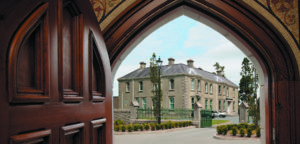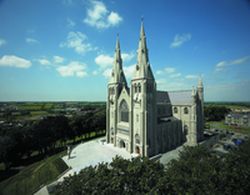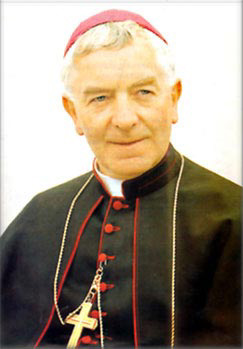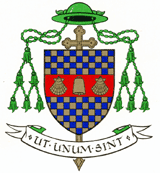OPENING OF ST. VINCENT DE PAUL CENTRE, ARMAGH
THURSDAY OCTOBER 16, 1997
ADDRESS BY CARDINAL SEAN BRADY
I congratulate St. Patrick’s Conference, of the Society of St. Vincent de Paul, Armagh on the opening of these fine premises. What an excellent way to celebrate the beatification of Blessed Frederic Ozanam, the principal founder of the Society. What an appropriate day, for today is World Food Day, for a ceremony of this kind. What a happy coincidence that the new Centre is located in the house which is traditionally regarded as the birthplace of St. Malachy.
St. Patrick’s Conference of the St. Vincent de Paul Society in Armagh was founded in 1865. It was the fourth Conference to be established in Ireland outside Dublin. The Conference has currently twenty-four members and I want to commend them most heartily on the outstanding work done locally and in the region, on behalf of the poor and the marginalised.
Earlier this year I attended Poverty Hearings in Belfast where people described their experience of poverty. It was most encouraging to hear so many people praise, very loudly, the help which they had received from the Society of St. Vincent de Paul. I know that the members of the Society of St. Vincent de Paul will be inspired by the knowledge that their work is appreciated so keenly.
I had the privilege of being present, in Paris, on 22 August last, when, in a magnificent ceremony in the presence of some 7,000 people, Pope John Paul declared Frederic Ozanam ‘Blessed’ in the great Gothic Cathedral of Paris, dedicated to Our Lady. The attendance was composed of many young people who were in Paris from all over the world, for the 12th World Youth Day. Also present were delegations representing St. Vincent de Paul Conferences from the five continents. They had special places in the nave of the Cathedral. The presence of so many young people was quite appropriate because it was on his twentieth birthday, in 1833, that Frederic Ozanam gathered together a group of his companions who were disturbed by the harsh living conditions of the poor. They shared the same desire of service to the most deprived, so they decided to do something about it. They got the addresses of several families in difficulty to whom they would bring some bread, and above all, much friendship. The finance came exclusively from their personal savings. Such was the humble origins of the first Conference of St. Vincent de Paul.
In his homily the Pope recalled how he himself was a member of a Conference of St. Vincent de Paul before the Second World War in Poland. In an earlier address Pope John Paul had said:
“We should thank God for the gift He has made to the Church in the person of Ozanam. We are amazed at all that was undertaken for the Church, for society, and for the poor by this student, this Professor, this father of a family, of intense faith and inventive charity during the course of a life too quickly consumed”.
Last August the wonderful destiny of this exceptional man, a lay saint for our time, was honoured in that ceremony in Paris. The members of St. Vincent de Paul Society have good reason to rejoice at this time.
Ozanam learned his love for the poor from his parents. His father was a medical doctor and was particularly kind to his poor patients. His mother, Madame Ozanam, helped her husband, visiting the old and infirm patients regularly. The story is told that in their old age and in failing health, the doctor and his wife pledged each other that in their visitations neither would venture higher than the fourth floor. Yet more than once they came unexpectedly face to face with each other, far higher up on the dark and steep staircases of those old houses in the city of Lyon. Frederick Ozanam was taught to see Christ in the person of all those who bear the heavy burden of human suffering and social injustice.
The Society of St. Vincent de Paul continues the best traditions of its founder. The members of the Society know that it is more blessed to give than to receive. They give of their time and of their talents and of their treasure. Each week at local Conference meetings a secret bag is passed around. Members contribute to it. Year after year the secret bag meets all the Society’s administration costs. The result is that all public contributions go in full, directly to the people in need.
All Christ’s commandments are summed up in love. Frederick Ozanam believed in that love, that is in the love which God has for every human person. He felt himself called to love especially those who have more need than others. Frederick made a special effort to seek those to whom the God of love could not be revealed except through the care and love of another person. By declaring Frederic ‘Blessed’ the Church is saying: “Frederic your road is really and truly the road of holiness”.
In his address at that ceremony Pope John Paul made a special appeal to the youth. He said that they must understand that if they want to be authentic Christians they must take the same route.
“Let them open their eyes, the eyes of their soul, to the numerous needs of so many people today. Let them understand these needs as challenges. Let Christ call each one of them by name so that each one can say ‘that is my road, that it the road I must follow”.
I know that the Society is giving thought to ways of attracting young people to join its ranks. Frederic Ozanam gave some thought to the same topic. At the age of sixteen he was disturbed by religious doubts. He was lucky that he had as his professor a man who was wise and gentle and who steered him through the storm into calmer waters. At the height of those temptations Frederic made a promise to God that should he be enabled to see the truth he would devote his whole life to its defence. He compared youth to a boat launched for the first time on the sea. “Now it speeds lightly over the wave crests now it sinks into the troughs of the sea until an experienced sailor takes the tiller and guides it safely into harbour”.
I know that educators will know the wisdom of his words when he says that young people need to see suffering in others if they are to learn to bear suffering in themselves. They need to know the meaning of hunger and thirst and of destitution. They need to see that they may learn to love.
The Society of St. Vincent de Paul is a lay Christian voluntary organisation, working with the poor and the disadvantaged. Let me remind you of something from the Mission Statement of the Society here in Ireland:
“We seek to respond to the call every Christian receives to bring the love of Christ to those we serve in the spirit of the Gospel message: I was hungry and you gave me to eat. No work of charity is foreign to the Society. Through person to person contacts we are committed to respecting the dignity of those we assist and so to foster their self-respect. We try to establish relationships based on trust and friendship”.
Members of the Society of St. Vincent de Paul help those they serve to achieve self-sufficiency in the longer term, and the sense of self-worth which this provides. They are committed to identifying the root causes of poverty and social injustice in Ireland. They work for the changes required to create a more just and caring society.
In a society where the gap between the ‘haves’ and the ‘have nots’ continues to widen the work of the Society of St. Vincent de Paul becomes ever more important. In 1996 its 11,000 voluntary workers continued to serve the needs of over 200,000 Irish people. They spent over sixteen and a half million pounds (£16,500,000) in the process. In the Annual Report for the Armagh Diocese, a total income of two hundred and fifty-five thousand pounds (£255,000) was recorded. That it a fantastic achievement.
Here we have an example of lay men and women taking very seriously their own special obligation of building up a more just society. By their words and their deeds they make known Christ’s message. The example of their Christian life and good work has the power to draw people rightly to believe in God. It is an example of what Christ was talking about when he said: “Let your light shine before men in order that they may see your good works and give glory to your Father who is in Heaven”. My prayer tonight is that St. Malachy’s Centre may remind all of us to see the poor as messengers from God to us, sent to prove our justice and our charity and to call us to make time and place for them in our lives. May God bless abundantly all who have made this Centre possible and all who will gather here in the future to do the work of the Society of St. Vincent de Paul.
